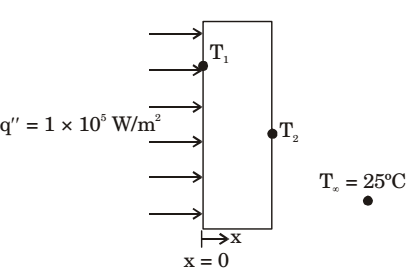Heat Transfer Miscellaneous
- Consider one dimensional steady state heat conduction across a wall (as shown in figure below) of thickness 30 mm and thermal conductivity 15 W/mK. At x = 0, a constant heat flux, q'' = 1 × 105 W/m2 is applied. On the other side of the wall, heat is removed from the wall by convection with a fluid at 25°C and heat transfer coefficient of 250 W/m2K. The temperature (in °C), at x = 0 is _______.

-
View Hint View Answer Discuss in Forum

Correct Option: A

- A material P of thickness 1 mm is sandwiched between two steel slabs, as shown in the figure below. A heat flux 10 kW/m2 is supplied to one of the steel slabs as shown. The boundary temperatures of the slabs are indicated in the figure. Assume thermal conductivity of this steel is 10 W/mK. Considering one-dimensional steady state heat conduction for the configuration, the thermal conductivity (k, inW/mK) of material P is ________.

-
View Hint View Answer Discuss in Forum

Correct Option: A

- A plane wall has a thermal conductivity of 1.15 W/mK. If the inner surface is at 1100°C and the outer surface is at 350°C, then the design thickness (in meter) of the wall to maintain a steady heat flux of 2500 W/m2 should be
-
View Hint View Answer Discuss in Forum
Q = KA dt dx q = Q = 2500 W/m² A 2500 = K 6dt dx 2500 = 1.15 × = (1100 - 350) x
x = 0.345 m.Correct Option: A
Q = KA dt dx q = Q = 2500 W/m² A 2500 = K 6dt dx 2500 = 1.15 × = (1100 - 350) x
x = 0.345 m.
- A cylindrical uranium fuel rod of radius 5 mm in a nuclear is generating heat at the rate of 4 × 107 W/m3. The rod is cooled by a liquid (convective heat transfer coefficient 1000 W/ m2K) at 25°C. At steady state, the surface temperature (in K) of the rod is
-
View Hint View Answer Discuss in Forum
Given data: r = 0.005 m
d = 2r = 2 × 0.005 = 0.010 mq6 = 4 × 107 W m3 h0 = 1000 W m2K
T0 = 25°c
For steady state,
Rate of heat generation in the rod} = Rate of convection H.T. from rod surface to fluid qG × volume of rod = h0 A(Ts – T0)qG × π d²l = h0 × πdl (Ts - T0) 4 d.qG (Ts - T0) = h0 4 h0 .010 × 4 × 107 = 1000 (Ts - 25) m24
Ts – 25 = 100
Ts = 125° c or 398 KCorrect Option: B
Given data: r = 0.005 m
d = 2r = 2 × 0.005 = 0.010 mq6 = 4 × 107 W m3 h0 = 1000 W m2K
T0 = 25°c
For steady state,
Rate of heat generation in the rod} = Rate of convection H.T. from rod surface to fluid qG × volume of rod = h0 A(Ts – T0)qG × π d²l = h0 × πdl (Ts - T0) 4 d.qG (Ts - T0) = h0 4 h0 .010 × 4 × 107 = 1000 (Ts - 25) m24
Ts – 25 = 100
Ts = 125° c or 398 K
- Heat is generated uniformly in a long solid cylindrical rod (diameter =10 mm) at the rate of 4 × 107 W/m3. The thermal conductivity of the rod material is 25 W/mK. Under steady state conditions, the temperature ditference between the centre and the surface of the rod is 1°C.
-
View Hint View Answer Discuss in Forum

Correct Option: A


